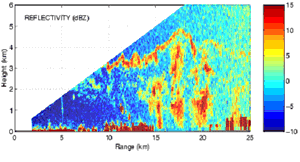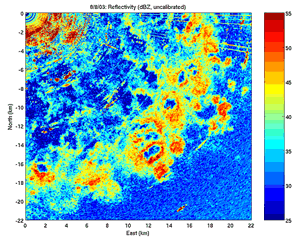Chilbolton 25m aerial
ACROBAT, the 1275 MHz Doppler clear-air radar is now fully installed at the STFC Chilbolton Observatory to add clear-air capability to the existing suite of instruments at the site. The radar is a fully coherent, single-polarisation, pulse compression Doppler radar. It is installed on the 25 m fully steerable antenna. The radar provides real-time measurement and display of the full Doppler spectrum, and the moments Z, v and w.
ACROBAT is an acronym for Advanced Clear-air Radar for Observing the Boundary layer And Troposphere.
Radar backscatter in the 500-1500 MHz range ("L-band" in radio terminology) occurs due to a combination of Rayleigh scattering from hydrometeors, Bragg scatter from turbulent refractive index inhomogeneities, and Fresnel reflections from layered refractive index structures. These returns from invisible refractive index fluctuations make the 'clear-air' radar technique possible.
The ACROBAT radar system can detect the backscatter from small variations in atmospheric refractive index, enabling the investigation of structures such as the boundary layer, convective plumes, and surface based and elevated radio ducts. The radar's Doppler capability permits the measurement and mapping of radial wind velocity, while measurement of spectral width enables identification of regions of enhanced turbulence.
Because clear-air Doppler radars are able to directly sense the motion of the air, they are most commonly employed as wind profilers, both operationally (by weather services and airports) and for research. Wind profilers point vertically, and measure the wind components by electronically steering the beam a few degrees off vertical. However, since the radar uses the 25 m steerable antenna, it has the unique capability of being physically scanned in almost any direction, allowing the user to obtain a 'snapshot' of the wind structure in a vertical or azimuthal plane.
The large antenna size provides a high gain to help achieve good sensitivity, and also leads to a particularly narrow beam-width for this class of radar (approximately 0.75°).
The radar was designed and built by RCRU engineers in collaboration with the University of Reading. The radar uses pulse compression techniques to maximise sensitivity whilst maintaining high range resolution. Computer-controlled transmit waveform generation technology, together with a PC-based data acquisition and processing system, provides considerable versatility in terms of custom operating modes. The radar utilises a travelling wave tube amplifier (TWTA), in conjunction with a programmable arbitrary waveform generator to generate the pulse stream transmitted from the horizontally polarised feed at the prime focus of the parabolic antenna.
The feed is a custom dual frequency design that is shared with the CAMRa S-band system. The feed is used for receive as well, and the signal is converted through a low noise downconverter and IF processing to produce linear I and Q output channels which are sampled in the PC based acquisition and processing system.
Examples of data
 Vertical slice of the atmosphere around Chilbolton using the ACROBAT radar. This shows a convective region breaking through the top of the atmospheric boundary layer.
Vertical slice of the atmosphere around Chilbolton using the ACROBAT radar. This shows a convective region breaking through the top of the atmospheric boundary layer. Plan view of the atmosphere around Chilbolton using the ACROBAT radar, showing convective regions “bubbling up”.
Plan view of the atmosphere around Chilbolton using the ACROBAT radar, showing convective regions “bubbling up”.